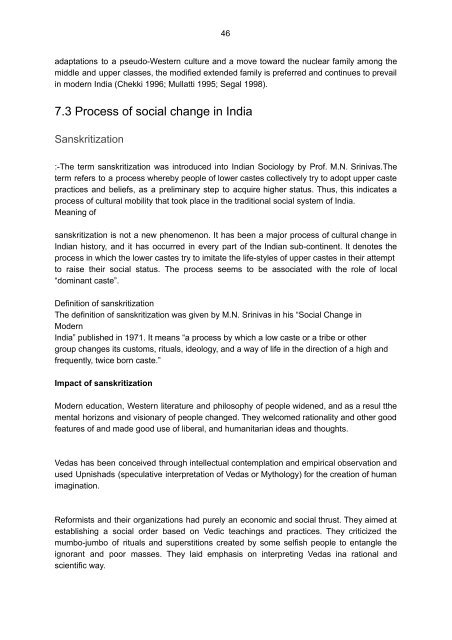F I - Google Docs
Create successful ePaper yourself
Turn your PDF publications into a flip-book with our unique Google optimized e-Paper software.
46<br />
adaptations to a pseudoWestern culture and a move toward the nuclear family among the<br />
middle and upper classes, the modified extended family is preferred and continues to prevail<br />
in modern India (Chekki 1996; Mullatti 1995; Segal 1998).<br />
7.3 Process of social change in India<br />
Sanskritization<br />
:The term sanskritization was introduced into Indian Sociology by Prof. M.N. Srinivas.The<br />
term refers to a process whereby people of lower castes collectively try to adopt upper caste<br />
practices and beliefs, as a preliminary step to acquire higher status. Thus, this indicates a<br />
process of cultural mobility that took place in the traditional social system of India.<br />
Meaning of<br />
sanskritization is not a new phenomenon. It has been a major process of cultural change in<br />
Indian history, and it has occurred in every part of the Indian subcontinent. It denotes the<br />
process in which the lower castes try to imitate the lifestyles of upper castes in their attempt<br />
to raise their social status. The process seems to be associated with the role of local<br />
“dominant caste”.<br />
Definition of sanskritization<br />
The definition of sanskritization was given by M.N. Srinivas in his “Social Change in<br />
Modern<br />
India” published in 1971. It means “a process by which a low caste or a tribe or other<br />
group changes its customs, rituals, ideology, and a way of life in the direction of a high and<br />
frequently, twice born caste.”<br />
Impact of sanskritization<br />
Modern education, Western literature and philosophy of people widened, and as a resul tthe<br />
mental horizons and visionary of people changed. They welcomed rationality and other good<br />
features of and made good use of liberal, and humanitarian ideas and thoughts.<br />
Vedas has been conceived through intellectual contemplation and empirical observation and<br />
used Upnishads (speculative interpretation of Vedas or Mythology) for the creation of human<br />
imagination.<br />
Reformists and their organizations had purely an economic and social thrust. They aimed at<br />
establishing a social order based on Vedic teachings and practices. They criticized the<br />
mumbojumbo of rituals and superstitions created by some selfish people to entangle the<br />
ignorant and poor masses. They laid emphasis on interpreting Vedas ina rational and<br />
scientific way.


